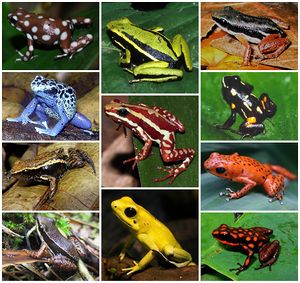Evolution in Family Dendrobatidae (Poison Frogs): Difference between revisions
No edit summary |
No edit summary |
||
| Line 9: | Line 9: | ||
[[Image:4_frogs.jpg|thumb|300px|right|Examples of bright coloration found in various species within the Dendrobatidae family. Image [https://www.joshsfrogs.com/catalog/blog/2018/03/what-dart-frog-is-right-for-me/ source]]] | [[Image:4_frogs.jpg|thumb|300px|right|Examples of bright coloration found in various species within the Dendrobatidae family. Image [https://www.joshsfrogs.com/catalog/blog/2018/03/what-dart-frog-is-right-for-me/ source]]] | ||
<br><br>Other examples: | <br><br>Other examples: | ||
<br><b>Bold</b> | <br><b>Bold</b> | ||
Revision as of 19:24, 9 December 2020
Introduction
The family Dendrobatidae, part of the class Amphibia, and more broadly, the kingdom Animalia, are a group of toxic frogs. These animals are commonly referred to as poison arrow frogs, dart poison frogs, or poison dart frogs.
Frogs within this family are found living in the tropical climates of Central America and the northern portion of South America. They are usually small in size, and are known for their vivid coloration, although there are exceptions to this trait. Their diet consists of ants and mites, which research has suggested are suppliers of the precursor molecules that make up the amphibians toxins. Frogs in this family derive their common name from the Columbian Indian practice of rubbing blow darts on the backs of frogs to coat them in poison for hunting.

Other examples:
Bold
Italic
Subscript: H2O
Superscript: Fe3+
Evolution
Include some current research, with at least one image.
Self Toxin Resistance
Sample citations: [1]
[2]
A citation code consists of a hyperlinked reference within "ref" begin and end codes.
Microbiome
Include some current research, with a second image.
Conclusion
Overall text length should be at least 1,000 words (before counting references), with at least 2 images. Include at least 5 references under Reference section.
References
Edited by Sydney McCallie, student of Joan Slonczewski for BIOL 116 Information in Living Systems, 2020, Kenyon College.

